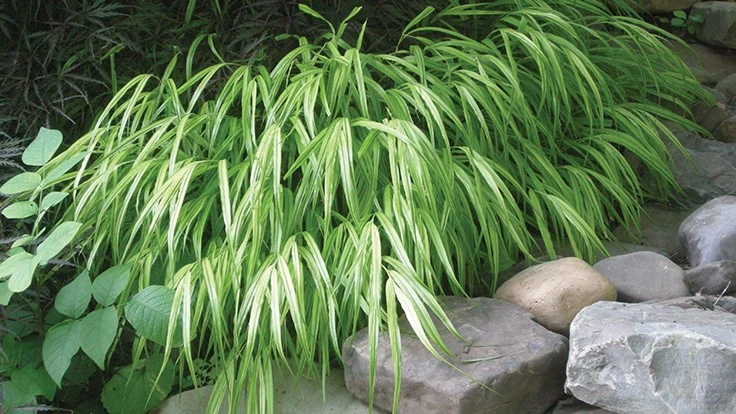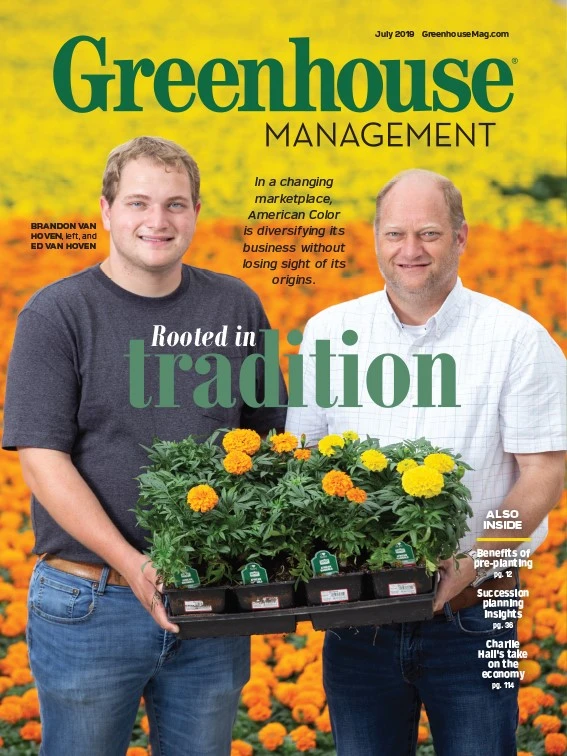

There are several categories of plant diseases you might expect to encounter occasionally when producing ornamental grasses. After all, these plants often originate from much drier habitats than those they encounter during production!
Grasses and other monocots appear to be more prone to fungal leaf spots and anthracnose diseases than other greenhouse and nursery crops. Additionally, rusts are often a problem and likewise root rots caused by Pythium and Fusarium spp.

Gray leaf spot caused by Magnaporthe oryzae affects Hakonechloa, while Bipolaris leaf spot (Bipolaris oryzae or B. zeae) can bedevil Panicum. A Leptosphaeria species causes Miscanthus blight. Rusts can frustrate Panicum and Miscanthus growers.
These diseases may be windborne from other grasses nearby, or inoculum can linger in old leaf debris within a container. Spores of the leaf spots mentioned above and those of rusts are usually disseminated by wind.
In contrast, anthracnoses produce sticky pinkish to salmon-colored spores in pustules on the leaf surface, thus these are most easily spread by wind-driven rain, irrigation or sprays. Little bluestem (Pennisetum) gets a curious disease called tangle top, caused by Myriogenospora atramentosa, which distorts top growth and forms a black line on affected leaves but does not appear to be easily spread. Root rots are frequently a problem in container production of grasses, where roots sometimes are provided with a wetter than ideal environment and lush high-nitrogen fertilization.

Many leaf diseases on ornamental grasses begin in spring and then may continue into summer if temperatures are not excessive for their unique needs. Rusts are more visible late in the growing season on these crops. Root rots may occur any time, but overfertilization can be a trigger for water molds and fungi to invade roots.
Salability of ornamental grasses is reduced by fungal leaf spots or anthracnoses on the leaf blades. Rust infection may result in pale spots on the upper surface of leaves — but the leaf orientation of a grass also makes the undersurface conspicuous, where numerous spore pustules of the fungus appear.

Here are some tips on preventing, monitoring and treating for pests and diseases in ornamental grasses and sedges:
Prevention of pest/disease
- Use mixes with good drainage.
- Inspect incoming plant material for disease symptoms.
- Keep grasses together and separate from other types of crop so that they can be watered according to their needs.

Monitoring for pest/disease
- Check foliage in spring, when you are at your busiest. Leaf spots often become entrenched during rainy spring weather.
- Remember to keep watching grasses in fall, as this is a key season for rust infections.
- Check root health on grasses periodically. Healthy roots are key to plant growth and winter survival.
Treatment of pest when present
- If you are a propagator, be very alert to disease symptoms and practice careful sanitation so that your customers will not acquire a disease problem.
- Consider a leaf spot outbreak to be an indication that irrigation is being done too often, for too long or both.
- Treat with fungicides at the first sign of leaf spot in a species with a notorious leaf spot problem.
- Rotate among materials with different modes of action (MoA). Check labels for FRAC codes that allow you to know which fungicides are different from one another regarding their MoA.
- For leaf spots, utilize contact materials such as chlorothalonil, copper or mancozeb, rotated with fungicides such as those in FRAC Groups 3 and 11.
- See labels for specific information about which fungicides may be used on each ornamental grass crop.
- Seek to discover cultivars that will perform well without fungicides. Take notes!

Explore the July 2019 Issue
Check out more from this issue and find your next story to read.
Latest from Greenhouse Management
- Anthura acquires Bromelia assets from Corn. Bak in Netherlands
- Top 10 stories for National Poinsettia Day
- Langendoen Mechanical hosts open house to showcase new greenhouse build
- Conor Foy joins EHR's national sales team
- Pantone announces its 2026 Color of the Year
- Syngenta granted federal registration for Trefinti nematicide/fungicide in ornamental market
- A legacy of influence
- HILA 2025 video highlights: John Gaydos of Proven Winners





